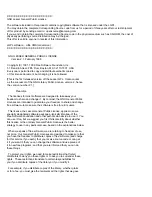
■
Under certain conditions, when aggregate interfaces are used and the member
links are located on more that one FPC, multicast traffic will not use one or more
of the aggregate child links. This can happen after an FPC reboot.
If the aggregate member links are located on the same FPC, this problem is not
triggered. To recover from this condition, deactivate and activate the aggregate
interface. [PR/484007: This issue has been resolved.]
■
The logical unit of a Gigabit Ethernet interface may show less than 1000 Mbps
of bandwidth even if there is no speed configuration under the physical interface.
As a workaround, manually set the bandwidth on the logical interface.
[PR/485840: This issue has been resolved.]
■
When loopback is configured on t3 under ct3, t1 under ct1, or e1 under ce1, no
error syslog message is logged. Additionally, the
show interface extensive
command on the t3/t1/e1 displays "loopback" even though it is not actually
applied. [PR/486424: This issue has been resolved.]
■
On an M20 router with an LS PIC, the backup Routing Engine kernel may core
at rnh_index_alloc. [PR/486646: This issue has been resolved.]
■
Traffic may be sent out on a child link of an aggregated Ethernet (AE) bundle
even when it is not in the Collecting-Distributing Link Aggregation Control Protocol
(LACP) state if and only if the following conditions are met:
■
The remote end configured one link to be primary and another to be backup.
■
On the System Under Test (SUT), a unit of the AE bundle is disabled, then
enabled.
As a workaround, deactivate and activate the child link that is not in the
Collecting-Distributing LACP state. [PR/487786: This issue has been resolved.]
■
With GRES configured, a container interface (CI) configuration can trigger a
kernel core on the backup Routing Engine. [PR/488679: This issue has been
resolved.]
■
Container interfaces with ATM children with OAM may not initiate sending of
OAM cells after Automatic Protection Switching (APS) switchovers. [PR/489250:
This issue has been resolved.]
■
Commit fails with IEEE 802.1p config when applied to container interfaces.
[PR/489400: This issue has been resolved.]
■
Kernel panic may occur if the child ATM interfaces are removed or disabled
under container. [PR/490196: This issue has been resolved.]
■
The system may not learn all MACs in the hardware within a second across the
fabric when trying to learn all new MACs at a 10–Gigabit line rate. A small fraction
will be learned via the software path, in the order of hundreds of seconds.
However, all MACs are learned eventually. [PR/489705: This issue has been
resolved.]
■
When filter-based forwarding is applied to the output interface and the egress
Packet Forwarding Engine (PFE) is different from the ingress PFE, the traffic gets
regular discards. [PR/490214: This issue has been resolved.]
■
During graceful Routing Engine switchover (GRES), if the peer's discovery state
is passive, the LFM state machine should be kickstarted even if the kernel state
is SEND_ANY, otherwise the peer will be stuck in PASSIVE_WAIT state. As a
76
■
Issues in JUNOS Release 10.1 for M Series, MX Series, and T Series Routers
JUNOS 10.1 Software Release Notes
















































